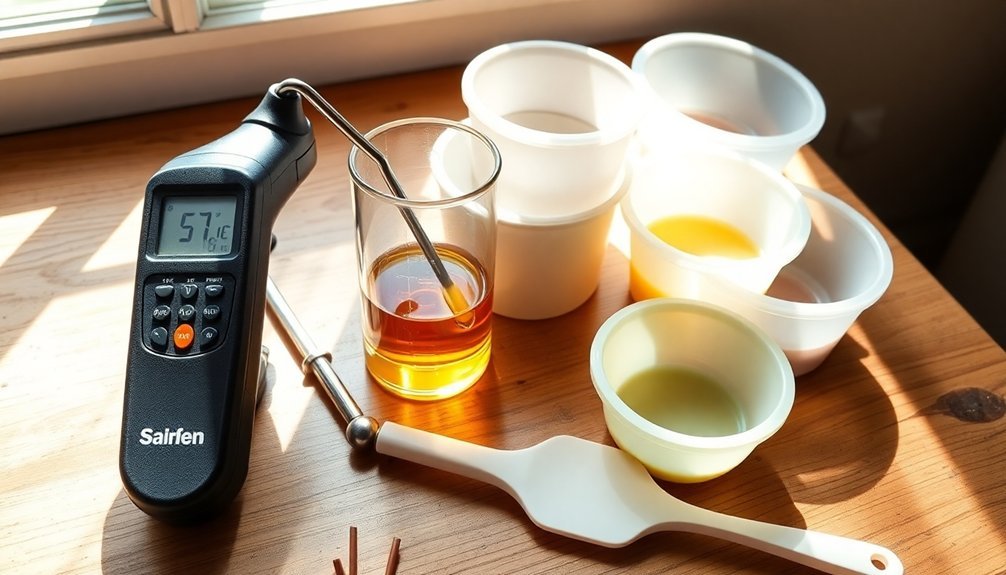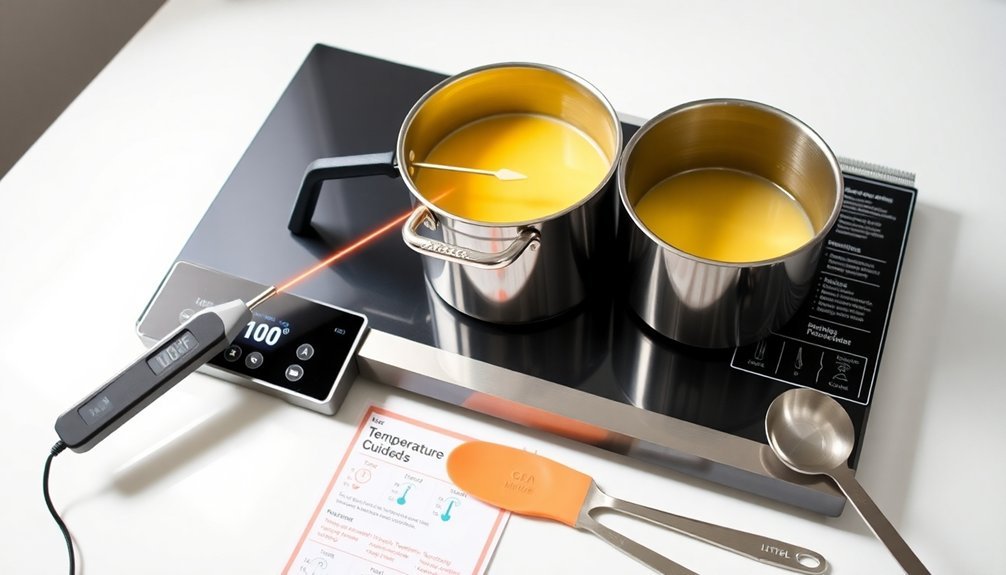For perfect soap temperature control, you'll need five essential tools. Digital infrared thermometers provide contact-free readings, while heat-resistant silicone bowls maintain stability without chemical reactions. Double boiler systems guarantee gradual warming of delicate ingredients, and temperature-controlled hot plates deliver consistent heat. Don't forget reliable thermometers that keep your lye solution and oils between the vital 95°F-105°F range. These tools will transform your inconsistent batches into professional-quality soap every time.
5 Tools For Perfect Soap Temperature Control

When crafting perfect soap, temperature control can make or break your batch. Your lye solution and oils must reach that sweet spot between 95°F and 105°F for ideal saponification process. This precision requires reliable tools.
A quality thermometer is your most essential investment. Industrial infrared models that measure from -22°F to +932°F will serve you through every soap making phase. Pair this with an immersion blender to quickly achieve emulsification while maintaining your target temperature.
Don't underestimate the importance of monitoring heat when adding fragrance oils and colorants to your soap base. Excessive temperatures can degrade these sensitive ingredients.
Track readings diligently for each batch of soap you create—this documentation guarantees consistency across future productions and helps you troubleshoot any issues that arise.
Digital Infrared Thermometers: Precision Without Contact
Among all temperature monitoring devices available to soapmakers, digital infrared thermometers stand out as true game-changers. They provide quick, accurate temperature readings without direct contact, making them ideal for monitoring both lye solutions and oils.
With measurement capabilities spanning -22°F to +932°F, these tools handle all soapmaking processes with ease. Their backlit displays guarantee you'll never struggle to read measurements, even during late-night soaping sessions.
The built-in laser pointers enhance accuracy by targeting precise measurement areas, reducing ingredient overheating risks.
For best soap temperature control, you'll want to maintain 95°F to 105°F for effective saponification. Digital infrared thermometers help you achieve this consistently while keeping your hands free for other tasks.
Always pair this technology with proper safety gear when working with lye solutions.
Heat-Resistant Silicone Mixing Bowls for Temperature Stability
Temperature stability, the holy grail of successful soapmaking, finds a perfect ally in heat-resistant silicone mixing bowls.
These non-reactive containers withstand temperatures up to 500°F (260°C), making them ideal for mixing lye solutions without warping or chemical interactions that could compromise your batch of soap.
Here's why you'll want these in your soapmaking arsenal:
- Superior temperature control throughout the soap-making process, maintaining consistency when working with heat-sensitive ingredients.
- Flexible design allows for easy pouring and complete removal of soap batter.
- Non-reactive material guarantees your lye solution remains uncontaminated.
- Versatile sizing options accommodate different batch requirements, from small test recipes to large production runs.
Their durability and heat resistance make silicone mixing bowls an investment that pays dividends in consistent, high-quality soap results.
Double Boiler Systems for Gradual Temperature Adjustments
While precision matters in every aspect of soapmaking, double boiler systems stand out as essential tools for achieving gradual, controlled temperature adjustments. You'll find this soaping tool invaluable when melting delicate butters and waxes, as it prevents burning and maintains ingredient integrity.
For ideal results, pair your high-quality melting pot with an infrared thermometer to monitor water temperatures between 140°F-160°F, guaranteeing your soap base heats evenly. Always choose a heavy-bottomed pot for the top section to eliminate hot spots.
| Double Boiler Method | Benefits |
|---|---|
| Gentle Heating | Prevents ingredient degradation |
| Temperature Control | Maintains consistent 60°C-71°C range |
| Even Heat Distribution | Creates homogeneous soap mixture |
| Improved Emulsification | Guarantees oils and lye combine properly |
This setup offers the precise temperature control necessary for professional-quality soaps every time.
Temperature-Controlled Hot Plates for Consistent Heat

Three essential qualities define professional-grade temperature-controlled hot plates: precision, reliability, and consistency.
These devices maintain oils and lye solutions within the ideal 95F-105F range, creating optimal conditions for saponification. You'll notice the digital displays provide accurate temperature readings, eliminating guesswork and reducing overheating risks.
When crafting quality soaps, consistent heat prevents:
- Separation of soap batter during critical mixing phases
- Inconsistent texture that affects the final product's appearance
- Temperature fluctuations that interrupt proper emulsification
- Wasted ingredients due to failed batches
The adjustable settings allow you to select specific temperatures for different stages—from melting fats to maintaining warmth during emulsification.
Frequently Asked Questions
What Thermometer Is Best for Soap Making?
For soap making, you'll find an industrial infrared thermometer ideal as it measures temperatures without contact. If you're budget-conscious, consider an analog instant-read or backlit cooking thermometer for accurate temperature monitoring between 95-105°F.
Is It Legal to Sell Homemade Soap?
Yes, you can legally sell homemade soap, but you'll need to comply with local regulations, register your business, obtain proper permits, and follow labeling laws. Don't make therapeutic claims, and consider getting liability insurance.
How Do You Keep Soap From Overheating?
You can prevent soap overheating by monitoring temperatures with a thermometer, using a double boiler for gradual heating, adding lye slowly, keeping ingredients chilled, and utilizing an ice bath during mixing if needed.
What Tools Do I Need for Soap Making?
You'll need a reliable thermometer, immersion blender, digital scale, measuring cups, and heavy-duty mixing containers. Consider investing in a soap base melter like FAST MELT to maintain consistent temperatures throughout your soap-making process.
In Summary
You'll find that mastering temperature control transforms your soapmaking results. By incorporating these five tools into your process, you're giving yourself the best chance for consistent, high-quality soap every time. Whether you're a beginner or experienced artisan, these tools eliminate the guesswork that often leads to failed batches. Take control of your temperatures, and you'll take your soapmaking to professional levels.





Leave a Reply